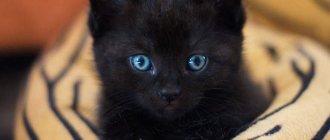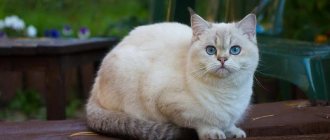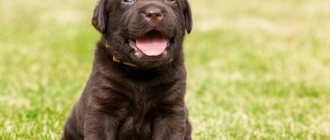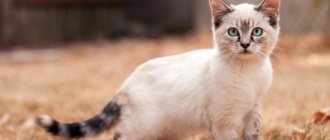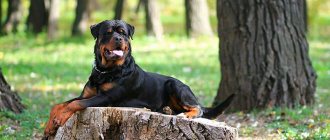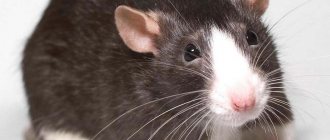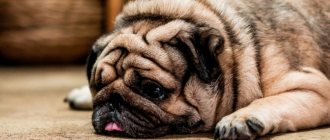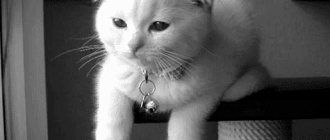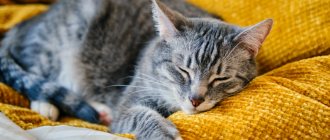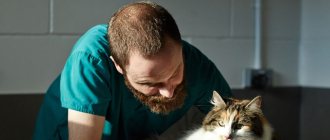The size and physiological maturation of animals depend on a large number of different factors. To know exactly to what age cats grow, it is necessary to take into account their breed, the functioning of the endocrine glands and their general health. Proper care and the creation of suitable conditions can affect the growth of a pet.
Tips for maintaining normal weight
To keep a British cat's weight within normal limits, owners need to maintain a balanced diet:
- add a small percentage of cereals and vegetables to dry and soft food;
- add boiled vegetables to the food (various varieties of cabbage, beets);
- meat and fish should only be lean, they should be included in the menu daily;
- Among the cereal products, it is best to give your cat oatmeal, millet, and rice;
- You need to cook porridge for your pet in water, without adding sugar and salt.
A kitten is taught to eat cereals and vegetables from an early age. The diet of an adult British cat should consist of 10–15% vegetables and cereals, 85–90% meat and fish.
Also, we must not forget about regular physical activity. To prevent a cat from developing obesity, the owner must engage it in active games every day.
High-quality and balanced nutrition, an abundance of vitamins and nutrients, an active lifestyle - these are the main factors for the full development of a British pet.
The owner should weigh the kitten at the same time every day in order to notice weight deviations in time. If the development of the “British” does not correspond to his age, then there is no need to hesitate in going to the veterinarian.
Many owners of purebred cats pay a lot of attention to the health of their pets. The weight of a British kitten is an important indicator of the healthy development of representatives of this breed, which is why owners are interested in what weight is considered normal for a particular cat breed.
Basic information, features, facts
Weight of a British cat, to what age do they grow, life expectancy?
An adult Briton weighs from 5 kg – 9 kg. Girls are smaller and weigh from 3.5 kg to 7 kg. Spayed and neutered animals gain slightly more weight. It all depends on proper nutrition.
Table - weight (g) of a British kitten by month
| Age | Boys | Girls |
| Newborn kitten weight | 65 — 140 | 60 — 130 |
| 1 Week | 230 — 270 | 120 — 240 |
| 2 weeks | 330 — 410 | 145 — 350 |
| 3 weeks | 390 — 620 | 200 — 410 |
| 4 weeks | 1 month | 545 — 740 | 245 — 550 |
| 2 months | 990 — 1650 | 440 — 900 |
| 3 months | 1450 — 2600 | 1000 — 1450 |
| 4 months | 2000 — 3800 | 1600 — 2300 |
| 5 months | 2500 — 4200 | 2100 — 2800 |
| 6 months | 2200 — 3500 | 2900 — 5300 |
| 7 months | 3200 — 5500 | 2300 — 3800 |
| 8 months | 3450 — 5900 | 2450 — 4000 |
| 9 months | 3700 — 6300 | 2400 — 4200 |
| 10 months | 4000 — 6600 | 2400 — 4300 |
| 11 months | 4200 — 6700 | 2400 — 4400 |
| 12 months | 1 year | 4400 — 6900 | 3000 — 4500 |
| Adult | 4500 — 8000 | 3500 — 5400 |
| Castrated | sterilized | 4500 — 9000 | 3500 — 6000 |
How many years do they live? The life expectancy of a British cat is influenced by certain factors: the presence of genetic diseases, proper feeding and care, vaccination, veterinary examinations, indoor or outdoor keeping, castration | sterilization.
Lifespan 12 – 16 years.
Basic physiological data of healthy cats, briefly
Body temperature (rectal): 38 – 38.5 ⁰C.
Breathing rate: 10 – 20 / min.
Duration of estrus: 10 – 12 days.
Favorable period for mating: during estrus.
Duration of pregnancy: 55 – 65 days, depending on the breed.
Age of a cat by human standards
| 18 months - 20 years | 9 years – 52 |
| 20 months – 21 years old | 10 years – 56 years |
| 22 months – 22 years | 11 years – 60 years |
| 2 years – 24 years | 12 years – 64 |
| 3 years – 28 years | 13 years – 68 years |
| 4 years – 32 years | 14 years - 72 |
| 5 years – 36 years | 15 years – 76 years |
| 6 years – 40 years | 17 years - 84 |
| 7 years – 44 g. | 19 years - 92 |
| 8 years – 48 years | 20 years – 100 years |
Behavior, character, habits
The British Shorthair is soft and calm, an excellent family companion. Loves affection, but is not the “me, me, me” type of cat. Will follow you around the house throughout the day, settling nearby wherever you go. These cats are unlikely to lie on your lap and do not like to be carried or held. Will enjoy the company of their human family members, spending time playing or sleeping in the same room. They are felines with a moderate level of activity. Energetic as a kitten, but begins to calm down when he is one year old. More mature British Shorthairs are usually “coolies”, but older males sometimes act like goofballs. When running around the house, they can sound like a herd of elephants.
Behavior in public places, instincts.
Each kitten has its own character and habits. British cats are calm towards strangers. One will make contact immediately, the other will observe from the side. If a cat rarely goes to public places or transport, he will be wary and hide - this is a normal reaction to an unfamiliar environment.
The British are an artificially bred breed, but the instincts have not gone away. British cats are excellent hunters, tested at the dacha and based on reviews from owners; Often cats need help during childbirth.
Attitude to extraneous sounds.
Extraneous sounds, rustles, objects arouse interest, and as a result the cat goes to investigate. At such moments, you need to come up and support, stroke and calm her, and explain. When the vacuum cleaner is running, they go into another room, there are cats from our litters who are absolutely calm about the vacuum cleaner, the new parents of the kittens said.
Behavior in the house, how to properly organize space.
The British love to play, the most active age is up to 4 months, they remain playful for up to a year, after which they become adults, important, calm, sleep and watch more. Based on observations of our pets, I can say that they love high play structures and sleep in houses only when it’s cold. Britons are large and weighty, so the complex with the scratching post must match. Among the toys they like are “flyers” with feathers or leather ropes, bouncy balls, and mice; mazes, boxes, etc. The main thing to remember is that the toy must be safe. British adults love to spend time with their owners at the computer and TV.
Toys, treats, suitable types of entertainment, is training possible?
Kittens love toys, especially new ones; if there is no new one, they can invent a toy for themselves: they will steal a hair tie (very dangerous because they can eat it), a candy wrapper, a piece of paper, or a cap from a plastic bottle. One of our graduates in her new house got used to removing a corner from the baseboards and moving it around the house.
They won’t refuse “sweets”; our pets have treats: vitamins, wet food and canned food.
Training is possible; in our nursery, from childhood, we teach him a scratching post, a name, a tray, and the word “no.”
Solitary behavior, sabotage, useful activities.
The British tolerate loneliness calmly, of course we are talking about the time when the owners are at work, mostly cats eat and sleep at this time, waiting for the evening.
If a Briton is offended, he will definitely show his dissatisfaction, he may be harmful, this will happen right away, he will not accumulate resentment.
British cats are for any movement in the house, for any repairs, they love to take part in it.
Communication with other animals, children, owner. Aggressiveness.
If a British cat is pedigree, she has pedigree titled parents, then 99%, she will be balanced, because... unbalanced ones are disqualified from examination and should not go into breeding, so it is important when buying a kitten to contact official nurseries.
Our beauty came to us before the birth of the child, but she accepted her daughter calmly, even slept with her in the crib. The kittens already appeared with the child, grew up, played together.
If the cat is “loner”, it will react aggressively to any strange animal.
It all depends on the character, one is more emotional and loves to talk, the other is calm.
If a British cat is not bothered by anything, it will behave calmly; if the cat has problems, it will definitely show it.
Several pets in the house, intersexual relations, attitude towards other pets.
While the mother is feeding, she treats the kittens normally, when the kittens grow up, she begins to be loyal to someone, while others can be annoying. Cats do not have the concept of mother-son; a cat-son can breed a cat-mother. Cats and cats can live together if they psychologically tolerate this living well. They are separated during estrus.
They bought kittens from us for a house where dogs lived, they all adapted and got along fine.
Attitude to heat and cold.
The British don't like hot beds. In summer, they often look for cool places (floors, tiles); in autumn and spring, before heating, vice versa. They sleep where they want and how they want, there is no one favorite place.
In what situations do they vote? How clean?
Depends on the character. The cat wants to talk - talk to him.
The British are very clean, they demand clean bowls and fresh water - this is right. They don't like to swim, but they tolerate it steadfastly.
Health, care
The British breed is healthy and does not suffer from many genetic problems. May have diseases: hemophilia B, hypertrophic cardiomyopathy, polycystic kidney disease, gingivitis.
Brush your teeth to prevent periodontal disease. Daily oral hygiene is best, but weekly brushing is better than nothing. Trim nails weekly. Wipe the corners of your eyes with a cotton pad containing a special solution to remove any discharge. Use a separate cotton pad for each eye to prevent infection from spreading.
Check your ears weekly. If they look dirty, dry them with a cotton pad and ear spray.
Correct British wool is similar to a mouton (plush), short, elastic, with a good undercoat. With a properly balanced diet, maintenance is minimal. We bathe cats once a year, brush them a couple of times a week with special combs or a rubber comb. During the molting period, you have to brush more often. The main thing is to choose the right care products and balance your diet. You cannot use slicker brushes with fine teeth without protected ends, you cannot wash them frequently, it is better to use special napkins for wool.
Omnivorous, prone to obesity.
The British are not very active; they prefer to lie down. The tendency towards inactivity means that you need to play with your cat regularly for its health and mental stimulation.
The British are picky eaters; if you find good food, the problem will go away. Neutered or sterilized cats are prone to overeating and obesity. We are responsible for those we have tamed and must monitor what we feed and in what quantity. It is better to use special feed, following the norm depending on the weight of the animal.
Read more about feeding here.
Causes of slow growth in cats
And the cat grew up big and big: how cats grow
You can often see that cats of the same breed look different. Due to slow growth, one of the pets may be smaller than its peers. This can happen for many reasons. Animals need vitamins, the lack of which affects the size of the cat and the formation of its organs.
These factors play a big role in the growth and development of cats and kittens. In comparison with their domestic peers, street animals look very contrasting. Their parameters immediately catch your eye. Due to a lack of vitamins, their immunity is weak, which affects the growth of the animal.
Having decided to take a pet into your home from the street, you don’t need to immediately switch it to dry food and stuff it with delicacies. It is best to add vitamins to his diet, and then the cat’s growth will catch up with its peers.
For this reason, the animal’s body may slow down its development for some period of time, and after a while the pet sharply grows. This is especially true for cats that have undergone castration.
To answer the question: how long do male cats grow, it’s worth taking a closer look at the animal’s parents. The way you see your parents is the way your children will be. All changes in appearance will directly depend on nutrition and other factors. If a cat grows, then he eats a lot.
Another option when you can find out about an animal’s growth is a consultation at a veterinary clinic. A specialist who examines your pet from birth will be able to accurately indicate the peak of its development. The living conditions of an animal are an important factor in the development of the animal. The doctor will be able to accurately tell you how and what to feed your animal, based on its breed and other indicators.
In order to raise a healthy animal and the moment of its puberty does not deviate from the standard development pattern, you must always keep in touch with a veterinarian. Only a doctor can help with advice on nutrition, care and maintenance of the animal. You shouldn’t focus only on your own strengths, because without knowing the anatomical features of a cat’s breed, it’s difficult to accurately understand how quickly it will grow.
A cat that has finally grown up can be allowed to reproduce at the age of one year. Early mating is not always beneficial for the animal. Early birth can lead not only to the death of the animal, but also to the birth of dead offspring. Before breeding an animal, it is best to consult a doctor.
The last important point in the development of your pet. Kittens are the same as children. As many sources confirm, those animals that do not receive enough attention from their parents - owners grow and mature more slowly, and then quickly age. The more attention your pet receives, the larger it will grow. A pet should receive not only breakfast and dinner, but also moderate games, affection from the owner and as much attention as possible.
There are several reasons why the active growth and development of kittens in the first important year of life can be significantly slowed down. Here are the main ones:
We often observe that animals of the same breed look different. The most common cause of slow growth is a deficiency of microelements and vitamins.
Living conditions also play a big role in the development of animals. Street ones look very contrasting compared to their domestic counterparts. They are smaller. Their immunity is weaker, which affects their growth. Therefore, when an outdoor cat appears in your home, you should not immediately switch it to dry food. You just need to add vitamins to his diet first. This way the pet will catch up with its peers in physical indicators.
Hormonal imbalances are another reason for the slow physical maturation of animals. This applies to pets who have undergone castration. Later they will catch up with their peers in height.
So, each animal has its own individual growth period
And the owner’s task at this time is to create optimal feeding and living conditions for him, to surround him with attention, to protect him from stress.. Sometimes you can notice that some representatives of the cat family differ in size from the rest
There are several reasons for this
Sometimes you may notice that some members of the cat family differ in size from the rest. There are several reasons for this.
The first is the lack of vitamins in the diet. Often observed in cats living outside. So if you take a barn cat into your home, there is no need to rush to feed it meat and various delicacies. It is necessary to introduce vitamin supplements into his menu, and he will quickly catch up with his brothers who grew up at home.
The reason for the slowdown in development is hormonal imbalance. The animal stops growing and then suddenly begins to grow again. This is often observed in neutered cats.
Content recommendations
The answer to the question of how long cats grow depends largely on proper care. Owners need to create the most suitable conditions for their pets. First of all you need to:
- Maintaining hygiene is no less important for cats than for people. The pet must always be clean and well-groomed. Once a month, the cat needs to be bathed and thoroughly brushed. The cat's litter box should be emptied regularly and the filling should be changed, and the food bowl should be thoroughly washed several times a week.
- Once a quarter, helminthiasis prevention should be carried out. This is done with the help of special drugs. You can find out the exact name and dosage from your doctor.
- If the animal suffers from any chronic disease, it is necessary to regularly see the veterinarian. Take courses of treatment or prevention as prescribed.
- Comprehensive vaccinations against feline infections need to be updated annually. Thanks to this measure, the cat’s risk of contracting a viral, bacterial or fungal infection is reduced. This also applies to pets who do not leave the apartment. Owners can bring the infectious agent on shoes or clothing.
- Proper nutrition plays an important role. There are special cat foods with vitamin and mineral supplements on sale. If the animal eats natural products, medications are purchased separately.
- You should not expose your cat to unnecessary stress - yell at him, physically punish him, etc. Jealousy has a bad effect on the animal’s psyche.
- Early mating will not benefit the cat's health. If a pet becomes pregnant before a year, she may experience hormonal imbalances and developmental arrest. The female’s body will devote all its strength to bearing offspring, and the cat herself may become seriously ill or die from exhaustion.
Compliance with these conditions will help raise a healthy and strong animal that will delight the owner for many years.
How old do cats grow?
How much do Yorkshire terriers weigh and what are their standard sizes + what age do these dogs grow to?
Height in cats is a relative concept. With age, they may become larger in both length and width, depending on the breed. And not only this affects the growth rate of a pet. Physical activity, diet, and general health all play a role here. Of course, there are average indicators that can be used to roughly determine at what age a pet will reach its maximum size. But they are different for each breed.
Scots
Among the Scots, one can distinguish lop-eared and straight-eared representatives. If we look at the general characteristics of the breed, we can see that by the age of three, cats’ muscle mass, skeleton, as well as eye color and coat color are finally formed.
Fold
Scottish Fold kittens are born weighing from 60 to 140 grams. It all depends on the number of brothers and sisters. In the first two weeks, the weight gain will be small and will not exceed 20 grams. In the future, growth will go faster, the main thing is to ensure that the kitten receives a sufficient amount of mother's milk. By two months, his weight should reach 1.5 kg, and by six months, up to 3 kg.
Scottish Folds develop to their maximum by the age of three. The weight of an adult male can reach 6.5 kg, and females 4.5 kg. By that time, they are already fully physically developed and ready to reproduce.
Straight-eared
Representatives of straight-eared Scots are somewhat larger than their fold-eared counterparts. Their growth rates are not much different, but their final weight is yes. Males by the time of their final development reach 7 kg in weight, while females can weigh 6 kg. This is due not only to nutrition. Genetics plays a big role here. Straight-eared Scots rarely have deviations in terms of height. And if the cat is also a purebred, then we can safely say that he will grow into a fat teddy.
British
The British begin to actively grow already at the age of one month. By then their teeth have formed and they can eat on their own.
Since, due to the characteristics of the breed, these felines are prone to obesity, their diet should be given increased attention.
Their musculoskeletal mass is finally formed by 2-2.5 years of life. But even after this they can continue to develop, until they reach the age of three. The weight of an adult male can reach 8 kg, and a female 6 kg. If you add two kilograms to each indicator, you can get the weight that these representatives of the feline family can gain after castration or sterilization.
Regular cats
Cats and male cats without claims to purebred also have their own developmental characteristics. As a rule, they reach the bulk and growth by two years. As mentioned earlier, a lot depends on heredity, nutrition and lifestyle. Sedentary animals that prefer to spend most of their time lying on the sofa can reach a weight of up to 9 kg. Moreover, these can be both males and females. Especially when it comes to castrated or sterilized cats.
In the latter case, special attention must be paid to nutrition. It will be better if you feed the animal with special dietary foods that have a balanced combination of nutritional components and are easily absorbed by the body
Maine Coon
There is a misconception that adult Maine Coons can reach up to 15 and even 25 kg in weight. However, despite the large growth (up to 100 cm in length) of the animal, the weight of an adult male does not exceed 12 kg, and the female is even less - 8 kg. They are born larger than kittens of other breeds: babies can weigh from 120 to 140 grams. And this only happens if there are several kittens in the litter. If the baby was born alone, his weight may be 160 grams.
Skin diseases
Unfortunately, Scottish cats are susceptible to skin diseases. A large number of varieties of diseases are difficult for the owner to diagnose independently, without veterinary experience. Symptoms are similar to allergies, scabies, eczema and demodicosis.
Based on typical signs of occurrence and development, skin diseases in the Scottish breed can be classified into three characteristic groups:
Attention! Infectious skin diseases of animals are contagious not only to animals, but also to humans. When caring for a pet, it is necessary to observe hygienic and sanitary rules and isolate the Scotsman from other brothers.
All skin diseases are pathogenic in nature and cause attacks of aggression in the pet:
Skin diseases harm the health of pets, and if urgent measures are not taken and professional treatment is not provided to the pet, the animal may die.
Hanging belly
When a cat has hanging skin on its stomach, this is not a pathology, but a genetic formation, which has the scientific term “primordial sac”. Popularly called fat tail, it is a natural property of wild felines. The Scottish cat breed has a hanging pedigree or rudimentary fold. In short-haired Scottish Straight and Scottish Fold cats, when the cat's belly hangs, it is more noticeable than in long-haired Highland Straight and Highland Fold cats.
The skin fold has a plumb line of 3-5 cm and stretches along the lower abdomen from the stomach to the paws. There is no scientific explanation for this feline feature yet.
Growths on the paws
This is a genetic pathology of Scottish Fold cats. The growths appear as a result of osteochondrodysplasia, which begins to appear in the early stages of development, so all owners need to monitor the condition of the pet’s limbs. At the first signs of the appearance of growths on the limbs, contact a veterinary clinic, where your pet will be examined. This disease cannot be cured, but prescribed medications will stop the further development of the disease and relieve acute attacks of pain in a sick pet.
Why does a cat grow slowly?
How long do castrated cats live?
This happens for various reasons, including:
lack of vitamins due to poor diet. So, for example, when an animal comes into the house from the street, they try to tidy it up with high-calorie food, forgetting about vitamins. To save an animal from vitamin deficiency, you should give it special supplements, which are sold in veterinary pharmacies and pet stores. When an animal eats ready-made food of good quality, it does not face a deficiency of vitamins and microelements;
Cat needs vitamins
- hormonal disbalance. Most often cats are susceptible to this, but neutered cats also experience such problems. After surgery, growth may slow down for a while, but then it continues at the same rate;
- parasitic infestation. Worms worsen the health of the animal, stop its growth, and contribute to weight loss. As a result of treatment, the cat quickly recovers and begins to grow and gain weight again.
Reasons for slow growth
The size to which and how a kitten will grow is determined by its heredity, that is, its genes. But in order for the opportunities inherent in nature to be realized, favorable external conditions are necessary. The main reasons why a kitten may be stunted:
- Poor nutrition. A kitten can be well-fed and well-fed and at the same time its growth may not correspond to the parameters of the breed. Why is this happening? During a period of intensive growth, the body needs a certain amount of not just nutrients or calories, but the quality composition of the food received is of great importance. The daily diet must contain the right amount of components important for growth: vitamins, proteins, calcium and phosphorus. Therefore, you should not neglect the recommendations of specialists; you need to adhere to a certain diet, taking into account the breed and age of the kitten. Only in this case will he realize the growth opportunities inherent in nature. In addition, proper nutrition greatly affects the health and immune system status of any animal.
- Diseases. It is clear that during the period of intensive growth, it is necessary to protect the young animal from the possibility of contracting infectious diseases. The owner must provide his pet with all necessary vaccinations and treatments in a timely manner. A common cause of stunting is helminthic infestations, to which young animals are very susceptible.
- Hormonal changes. Growth rates may be affected by the time of spaying or neutering, so you should discuss the issue with your veterinarian before surgery.
Thus, if you want to raise a beautiful animal whose constitution will correspond to the breed criteria, you need to devote some time, mainly to self-education in matters of feeding and maintaining your pet. And we must remember that omissions during a period of intensive growth are difficult to compensate for in the future, and often impossible.
Cute video: How a kitten grows
https://youtube.com/watch?v=jAASLCqhw1w
What are the dangers of obesity?
You can tell that a cat is obese by its sagging belly. Because the fat layer is too thick, the costal and vertebral bones cannot be felt. An obese animal moves slowly and ignores active activities.
ATTENTION! An obese cat needs to be examined at a veterinary clinic for prevention, as there is a high probability of developing diseases of the heart and vascular system, as well as inflammation of the joints.
Excess weight greatly affects the health of a British pet. The most common pathologies:
- increased blood pressure, development of atherosclerosis;
- lethargy, powerlessness, drowsiness;
- hormonal disbalance;
- blurred vision due to increased intraocular pressure;
- development of diabetes;
- the appearance of gout, osteoarthritis;
- disruption of the digestive tract;
- hard breath;
- thirst;
- deterioration of metabolism;
- weakening of the immune system.
Dependence on breed
The age at which a cat grows largely depends on the breed.
British cats are especially popular among pet lovers. This breed is distinguished by a short, bluish-gray coat that resembles a plush one. The expression on their faces can be very funny, and their disposition can be light and affectionate.
Females of this breed gain weight up to 6 kg, and after sterilization they can grow up to 8 kg. An adult British cat gains up to 8 kg of body weight, and after castration, up to 10 kg. The age at which British cats grow is 3 years; in female cats, maturation occurs faster - by 1.5 years. If pregnancy occurs, growth is interrupted during this time, but then the female makes up for the lack of weight.
The Scots have growth parameters and development periods that coincide with the British. But Scottish kittens have a more balanced character.
In sphinxes, puberty begins early. Cats can stop growing as early as 5-6 months, at which time they can become pregnant. Sphynx cats grow until about 2.5 years of age. An adult cat can weigh from 2 to 4 kg, and a male cat can weigh from 4 to 6 kg. The breed is prone to overeating and gaining excess weight. This is easy to identify by body shape, since sphinxes do not grow hair.
It is very important to monitor their diet
Maine Coons are considered the largest of all domestic purebred cats. This breed originates in North America. The weight of an adult male after castration is usually within 10 kg. However, they are distinguished by strong bones, wide paws and long fluffy hair. This increases the size of Maine Coons visually. The record holder of the breed is a cat whose length from nose to tip of tail is 1 m 23 cm.
Since this breed is generally large in size, kittens take a long time to grow. In the first year of life, their growth is most intense. At the age of 4 months, a Maine Coon kitten looks like an adult cat of another breed. Its body weight is about 4 kg. At the age of 11-12 months, growth slows down somewhat. Complete growth occurs at 3.5 years. By this time, females weigh up to 8.5 kg, and males up to 12 kg.
Siberian cats and cats are a breed formed in the natural conditions of Western Siberia and the Urals. They are distinguished by their strong build and good health. These animals are massive, they have a wide head, and the body is set low. Siberian cats grow up to 3 years old, the weight of males reaches 10 kg, and females - 6 kg.
Care
British cats should be taught to use a comb from childhood, as the fur on the belly is quite difficult to comb. They have a fairly good, thick undercoat, so for this procedure it is better to use a slicker brush with metal teeth rounded at the ends. Brushing twice a week is enough for the animal to get used to the “beauty session” and enjoy it. During shedding, you need to brush more often. The British breed is the only breed that enjoys brushing and stroking against the coat.
Britons give birth to very large cubs and, as they grow up, they become very active with a large source of energy. The cat takes very touching care of the kittens and almost never lets them go. The cubs open their eyes after about a week. Kittens grow very quickly and become large and dense, but they do not get fat. The cat grows until about four years of age and reaches full bloom at five years of age.
When choosing a British kitten, be vigilant. The ideal age for a kitten to be rehomed is between 12 and 16 weeks. British cats usually have small litters, as the kittens are born strong and large. By three months, they not only have good physical development, but also acquire social skills.
On average, British Shorthair cats live 18-20 years. A British cat can be considered an ideal acquisition for a number of reasons. They exude kindness, they have a pleasant character, a presentable appearance and a calm temperament. All this ensured this breed great popularity. Due to their character and low maintenance requirements, cats are ideal for owners who spend all their free time working.
It is worth keeping in mind that this description is typical for the breed as a whole and may not completely coincide with the characteristics of a particular cat of this breed!
Factors affecting dimensions
The growth and maturation of a cat is influenced by external factors and features of physiological development. These include:
Breed is one of the most important factors affecting the height and weight of an adult animal, as well as the age at which it reaches adulthood. In outbred domestic cats, the genotype is most often mixed, so it is unlikely that it will be possible to determine the exact timing of development. Some kittens grow up to 3 years old, while others reach their maximum height and weight by one year. Heredity - the size of an animal largely depends on the size of its parents. It is extremely rare for small cats to give birth to large kittens. Gender of the animal - males always grow larger and heavier than females. Living conditions - growth is influenced by a comfortable room temperature, sufficient light, good restful sleep and the baby’s nutrition. State of health and presence of any diseases. The pathology can be any - somatic, infectious, parasitic or genetically determined
The correct functioning of the endocrine glands is also important. Physical activity and lifestyle - the more a kitten moves and plays, the better it grows. His body develops proportionally, and his weight is normal for his age and breed. Castration, especially performed in adulthood
Cats that are sterilized at the age of 2-3 years and older grow larger than those that were neutered before a year or were not sterilized at all.
Health
British cats are one of the healthiest cats, as they do not have any serious health problems. This breed has a good gene pool, so the British have been used to develop new breeds for many years. The only contraindication is drafts, since sitting in a draft can easily catch a cold. It is better to protect a pet of this breed from fatty foods, as there is a tendency to become overweight. To achieve an ideal balance in nutrition, you should switch the animal to ready-made canned and dry food. During the growth period, kittens, pregnant and lactating cats need to add natural food to industrial food.
The British breed is never crossed with the Scottish Fold, as the result is sick kittens with paralysis and dysplasia. In the 70s of the last century, a kitten with hemophilia was born, breeders certainly began work to identify carriers. As a result of the work, scientists found that the majority of British people are born with blood type A, and a minority have blood type B. Mating of animals with different blood groups leads to a conflict of Rh factors, that is, incompatibility. The British breed is characterized by late maturation. By the age of three to five, British kittens are fully mature, but thanks to this delay in development, they look young in adulthood. Representatives of this breed are long-lived, usually living up to 20 years.
Russian nurseries
Where can you buy a British kitten in Moscow:
- Tamaky*ru, Cattery of British cats Moscow. They offer British Shorthair kittens of different colors and ages with vaccinations and certificates.
- Style of Provence, nursery of British cats by Lyudmila Mikheeva. They have been breeding professionally for 10 years. Pets are offered vaccinated, trained and with a set of bright photographs.
- Joy Land, a British cattery, breeds pets of blue and lilac, cream and cinnamon colors.
Before you bring the furry miracle home, you need to remember: an animal, not a toy. This is a living creature, small and defenseless. And it is the owner’s responsibility to take care of it.
What kind of eyes do the British have?
Against the backdrop of the expressive face of the British cat, the large and round eyes really stand out. They are always set wide apart and have a clean, bright look.
At 4 months, Britons' eye color usually begins to change depending on their coat color. Only an experienced specialist can tell you the final color result at this age. For example, a cat can become blue-eyed only if its coat is white.
Another feature of snow-white cats is the ability to have eyes of two colors: blue and yellow, gold and copper, blue and copper. Cats with silver colors and tabby patterns usually have green eyes. All other color variations of coat colors have mostly swamp eyes in childhood, gradually acquiring an amber, copper tint.
Note! The outline of the iris of the eyes of British cats should correspond to the general tone. A darker outline is considered a defect.
Factors influencing the growth and development of a kitten
The main role in regulating body functions (including growth function) belongs to the endocrine system, namely the pituitary gland. The anterior lobe of the pituitary gland produces the growth hormone somatotropin. This biologically active substance ensures the growth of bones and cartilage, and takes part in the formation of muscle mass. No less important is the general hormonal background, which is created by the work of the thyroid gland, reproductive system and adrenal cortex.
There are several other physiological factors that shape the body’s ability to actively grow:
- Breed characteristics. Cats of small breeds go through physical development somewhat faster than their large relatives.
- Belonging to one gender or the other. Males gain weight more actively.
- Hereditary characteristics. The kitten adopts its character and growth characteristics from its parents. You can understand what an animal will be like at the peak of its development by looking at its mother and father.
The rate of physiological growth of cats is greatly influenced by the external circumstances and conditions in which they live and are raised, as well as the characteristics of their care:
Habitat. If kittens grew up in a cold climate, with few sunny days, then their metabolism was slowed down. This means that they will lag behind in development from their relatives, who have lived their entire lives in the south. Lifestyle. Domestic cats living in warm conditions, receiving enough food and all the nutrients they need, have good immunity and develop faster than street animals. Amount of sleep and rest. The cat needs to sleep enough time. If in childhood animals are playful and active, then in adulthood the normal amount of sleep for them should be 17-20 hours a day. Physical activity also plays a role in development. The animal must be given enough space and opportunities to play. Hereditary and acquired diseases. Owners must take all measures to protect their pets from possible infections.
In this sense, the importance of preventive vaccinations cannot be overestimated. Early castration and sterilization significantly pushes the limit of active growth. After surgery, the rate of growth and weight gain decreases significantly. Early pregnancy has a similar effect
After its onset, the priority for the body becomes bearing and then feeding the offspring.
Osteochondrodysplasia
The genetic disease is osteochondrodysplasia of Scottish fold cats (OSF), a common, incurable disease that affects the bones and joints of the animal. Caused by the presence of an individual gene for “loop ears”, which is specific to the Scottish Fold and Highland Fold. Diseases of Scottish Fold cats appear in newborn kittens in the first months of life.
OCD, a hereditary disease, is transmitted regardless of the sex of the animal from offspring to parents. To protect animals from the transmission of heredity, mating within the Scottish Fold and Highland Fold species is prohibited; interspecific mating is allowed only within the Scottish breed with straight-eared cats - Scottish Straight, Highland Straight. If you follow the rules of crossing, the risk of developing DCD is greatly reduced.
When OCD manifests itself, bone tissue grows around the joints, and the bones and cartilage of the entire spine skeleton, starting with the tail, and limbs are affected.
It is impossible to cure a gene disease at the present stage; measures are being taken to stop the development of the disease.
Symptoms
The disease osteochondrodysplasia of Scottish cats appears already in the first months after the birth of a kitten, in rare cases in adulthood. And if at first it is little noticeable, then it quickly progresses with age. Main symptoms to look out for:
If these signs are present, contact specialists. There they will make a correct diagnosis and prescribe treatment.
Treatment
To the veterinary clinic, in order to make a correct diagnosis of the Scottish fold cat and prescribe treatment:
If therapeutic treatment does not bring relief, it is prescribed for arthrosis or osteotomy - a surgical operation.
Important! Veterinarians first diagnosed osteochondrodysplasia in Scottish fold cats in 1971. Having finally become convinced of the incurability of the disease, specialists from felinological associations called on breeders in 2022, for humanitarian reasons, to stop breeding the breed, which is a type of frequent occurrence of musculoskeletal defects that lead to suffering and death of Scottish Fold and Highland Fold animals.
What kind of hair do British cats have?
Special attention should be paid to British wool. Thanks to the harsh living conditions of the past, these animals have acquired an excellent coat with a very dense and thick undercoat.
Despite the fact that the structure of the wool itself is thin, it feels quite elastic and soft to the touch. Therefore, representatives of this breed are often called plush. In addition, the coat of British cats is distinguished by beautiful, shiny colors. British cat care and maintenance >>
At the moment, there are about 60 colors that the British have. It can be any solid color, smoky, tortoiseshell, tabby, chinchilla, bicolor or colorpoint. The most common among them are solid blue, as well as two-color tabby and chinchilla.
Important! The British Shorthair's coat should be the same length all over the body. As a rule, it does not exceed 2.4 cm
A healthy British cat never develops tufts of fur, so he can easily take care of his coat on his own.
Varieties of the British breed
The varieties differ only in the length of their fur.
There is only one variety - the British Longhair cat. Occasionally, kittens with long fur were born. This phenomenon happened when British cats were crossed with Persian cats. This is how English breeders experimented. But it is worth noting that true Britons also had long-haired cubs long before this. As a result of experiments, a gene responsible for the development of long hair was isolated in short-haired cats. Considered “weak”, it may not manifest itself at all. A kitten with long hair appears only from those parents who are both carriers of the “weak” gene.
It was noted that crossbreeding with the Persian breed resulted in asymmetry of the skull and some misalignment of the jaw. Significantly deep depressions appeared on the bridge of the nose, and the fur became soft. In this regard, further crossbreeding was prohibited. And the most successful remaining hybrids continued to spread throughout the world. This is how the British longhair cat appeared.
According to experts, the two types of cats differ from each other only in the length of their fur. Moreover, the fur of British cats that have exhibited the “long hair gene” does not cause any problems: the fur does not mat and does not require special care.
note
Sometimes Scottish Fold cats are crossed with British Shorthair cats. Therefore, some people mistakenly believe that there are lop-eared Britons. In fact, the Scottish Fold and the British Shorthair are completely different breeds.
What effect does belonging to a particular breed have on the growth of cats?
How do the British grow up?
Many cat lovers choose this breed. The British have a blue, plush-like coat, a funny expression on their face, and the same funny, playful character.
Cats gain weight up to 6 kilograms, sterilized up to 8. The weight of an adult cat is about 8 kg, and for neuters it can reach up to 10.
The growth period for cats extends to 2–3 years. The growth of cats usually ends by 1.5 years, or earlier if it is interrupted by pregnancy, after which the cat can gain weight.
How do sphinxes grow?
Due to the early onset of puberty, in cats of this breed - by 5-6 months, growth may stop at this age, due to the start of exploitation of the reproductive system. The growth of Sphynx cats can last up to 2.5 years.
The average weight of a cat is 2-4 kg, a cat is 4-6. Sphynx cats are prone to overeating, so you need to monitor their weight and diet. Since sphinxes have no hair, fatness is easy to determine visually.
How do Scottish Folds grow?
Kittens of this breed are distinguished by a calm, imperturbable, balanced character. The ears can droop, or they can remain erect, which is usually determined after weaning and is difficult to predict in advance, since lop-eared, according to breed standards, are necessarily crossed with “straight-eared” brothers.
Growth parameters coincide with those of the British cat breed - growth ends by the age of three, the average weight of adult cats reaches 8 kg, cats usually do not exceed 6 kg.
How Maine Coons grow
The Maine Coon breed comes from North America. Representatives of the breed are considered the largest representatives of domestic cats. Although the weight of an adult castrated cat rarely exceeds 10 kg, the abundance of hair, powerful paws and bones visually almost double the size of the cat.
The length of the body, from the tip of the tail to the tip of the nose, is 1m 23 cm - this is a breed record. The body weight of a castrated male reaches 12 kg.
As representatives of a large breed, kittens take a long time to grow. Growth is most intense in the first year of life. By 4 months of age, the kitten looks like an adult cat of smaller breeds and weighs approximately 4 kg. As the year approaches, growth slows down a bit. Maine Coons stop growing by the age of 3-5 years; by this time the weight of an adult cat can be about 12 kg, females 8.5 kg.
How do Siberian cats grow?
The cat breed originates from the northern regions of Western Siberia and the Urals. Cats of the Siberian breed are distinguished by good health and a strong physique, which is typical for naturally formed breeds. Outwardly they resemble Norwegians, but unlike them, they are more massive, have a wider head and a low body. The weight of a cat is up to 6 kg, a cat – up to 6-10 kg. Growth continues up to 2-3 years.
Feeding and caring for the British Shorthair breed
Since cats have rich fur, they need to be brushed regularly. It is enough to resort to this procedure once a week. For combing, it is recommended to purchase rubber combs. First, they are carried out against the animal's fur, and then along the hair growth. During the shedding period, grooming should be more frequent.
As for swimming, it is optional. An exception can be made only in the case of very heavily soiled fur coats. To maintain cleanliness and shine of the coat, it is enough to use dry shampoos.
In order to prevent inflammatory diseases of the gums and teeth, it is necessary to monitor the oral cavity and brush your beloved cat’s teeth. This hygiene is done approximately once a week. Other procedures worth noting include wiping the ears with a swab and periodically trimming overgrown claws.
Particular attention should be paid to feeding British shorthaired pets. This is associated not only with a tendency to obesity, but also with maintaining the quality of the coat.
To maintain optimal shape, an adult pet requires 70 kcal per 1 kg of weight. The bulk of the feed should be lean meat. In addition, vegetables, grains, fish, and dairy products are required in the diet.
You can also feed with ready-made food, for example Royal Canin for British shorthair cats.
Health of British Shorthairs
Since the breed is a product not only of targeted crossings, but also of formation in natural conditions, its representatives have fairly good health. Serious hereditary diseases have escaped the British Shorthair breed. However, during development, animals can exhibit three diseases: gingivitis, polycystic kidney disease and dystrophic cardiomyopathy.
The latter disease is considered incurable and requires owners to regularly examine their pets at the veterinarian, as well as an ultrasound of the heart. The following signs are warning signs of serious heart problems:
- Decreased interest in the outside world.
- Loss of body weight.
- Weak heartbeat.
- Shortness of breath accompanied by wheezing.
- A bluish tint to the paw pads.
Another breed problem that occurs most often is obesity. Excess weight gain is observed after castration with excessive eating and a sedentary lifestyle. The only way out in this situation is to control nutrition and consciously involve pets in outdoor games.
Despite their good immunity, kittens of this breed are vulnerable to infections and viruses before reaching the age of one and a half years. Vaccinations begin before the age of 2.5 months. Vaccination is repeated every 3-7 weeks. After 15 weeks, vaccinations are given once a year.
If the breeding pair is selected correctly, repeated close inbreeding is excluded and the blood type is taken into account, then the cats will have excellent health. All important breeding factors are necessarily taken into account in nurseries, which allows us to say that a purebred British Shorthair cat is a healthy creature. Health allows you to bear strong cats without problems. The duration of pregnancy is 63-65 days.
With careful care and health care, the life expectancy of British Shorthairs reaches up to 15 years, maintaining good health, excellent appearance and a stable mental state.
